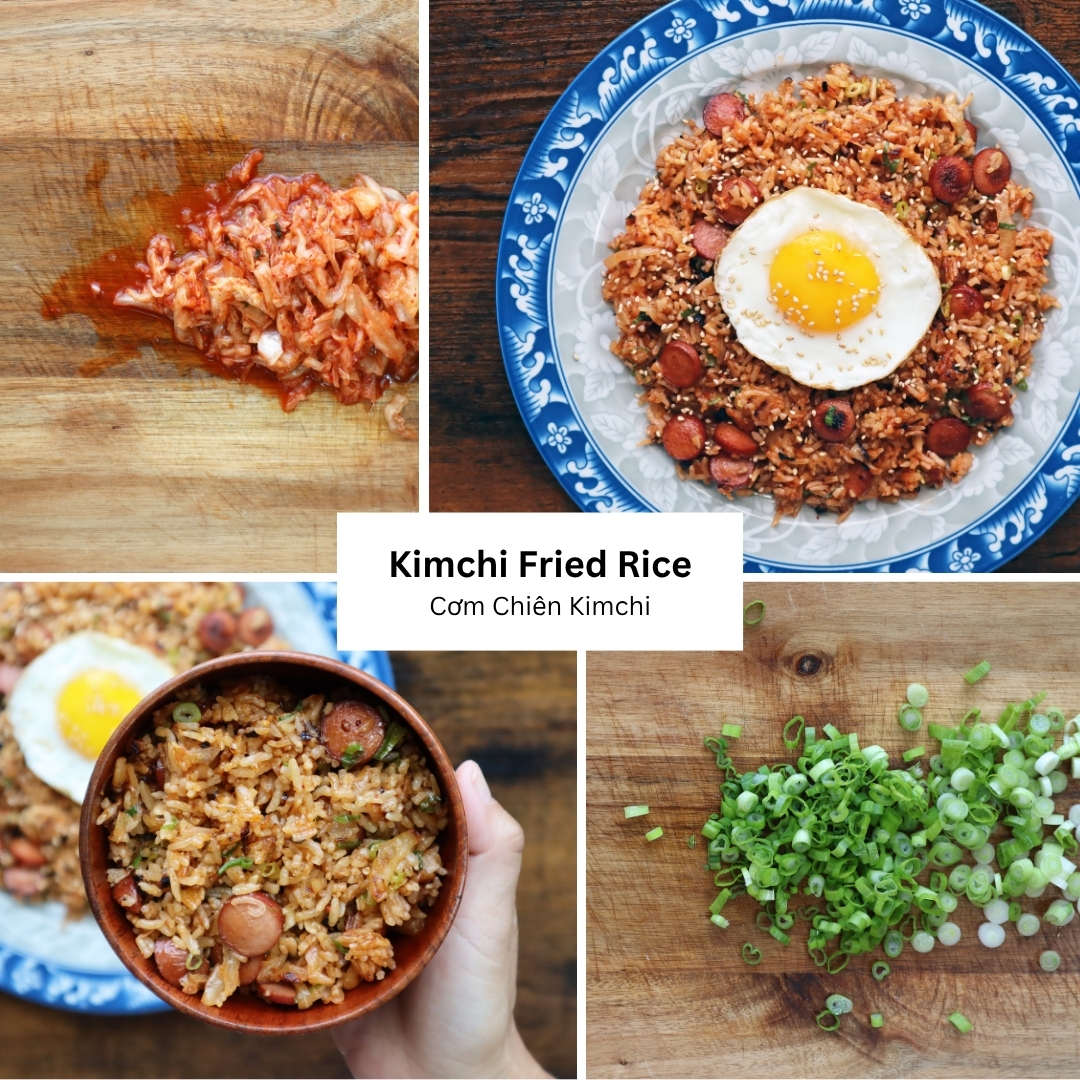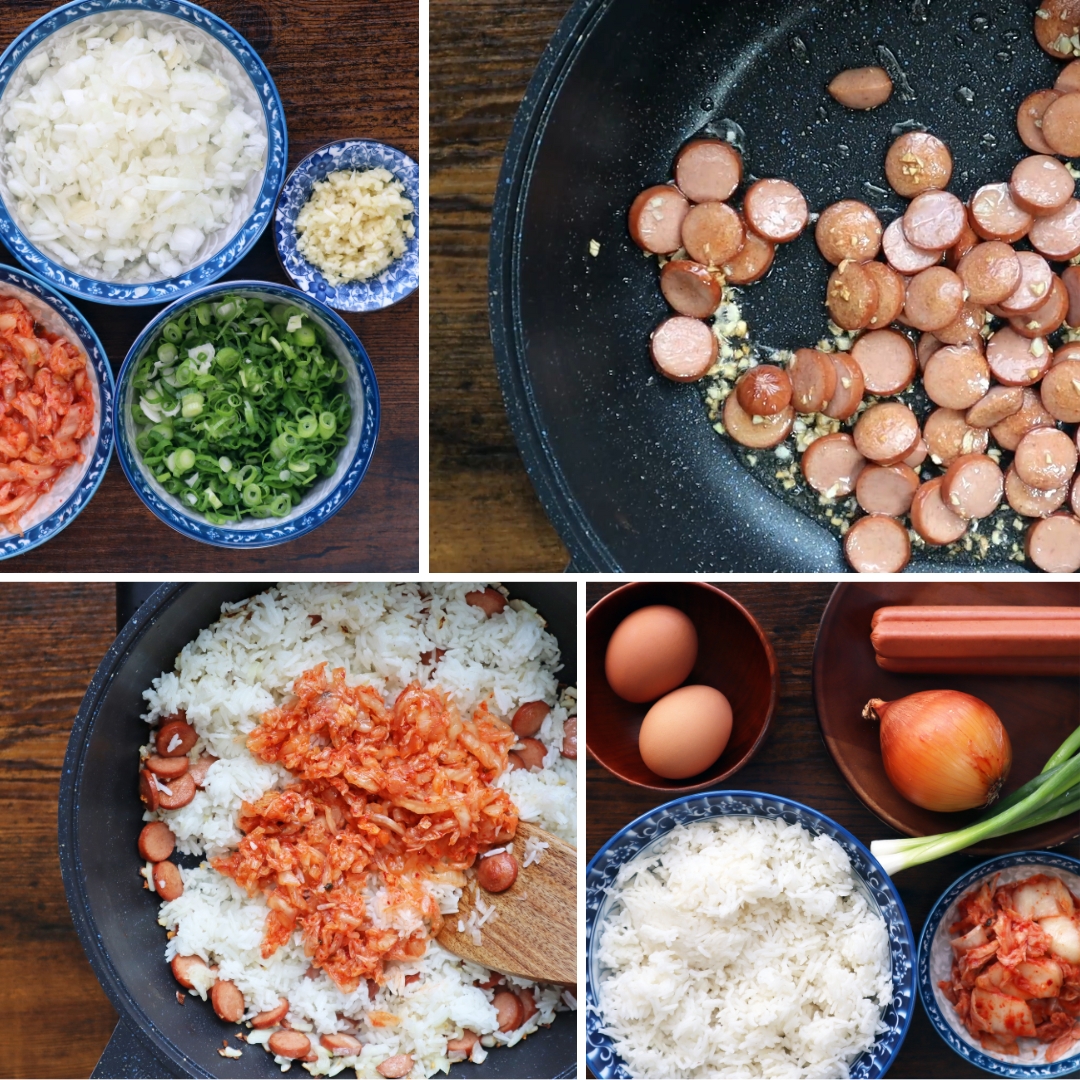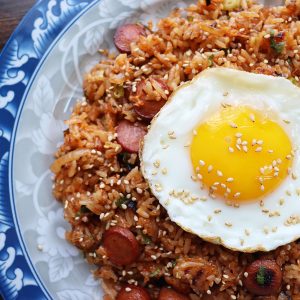Kimchi Fried Rice (Cơm Chiên Kimchi)
Discover the Magic of Kimchi Fried Rice
Kimchi is more than just a side dish – it’s a cornerstone of Korean cuisine and culture. Made from fermented vegetables, most commonly napa cabbage and radish, kimchi is celebrated for its bold, tangy flavour and its vibrant red hue. For generations, Korean families have gathered to make kimchi together, a tradition known as “kimjang,” which is even recognized by UNESCO as an Intangible Cultural Heritage. Beyond its cultural roots, kimchi is also prized for its health benefits, thanks to natural probiotics and a wealth of vitamins.
But kimchi isn’t just for eating on its own. It’s a versatile ingredient that can transform everyday meals into something truly special. One of the most beloved ways to enjoy leftover kimchi is in Kimchi Fried Rice – a dish that’s as comforting as it is flavourful.

Kimchi Fried Rice, or “kimchi bokkeumbap,” is a staple in many Korean households, and for good reason. It’s quick to make, incredibly satisfying, and a fantastic way to use up leftover rice and whatever protein you have on hand. The zesty, spicy kick of kimchi infuses every bite, while the addition of hot dog, ham, or even leftover chicken makes it hearty enough for any meal. Topped with a sunny side up egg and a sprinkle of sesame seeds, this dish is as beautiful as it is delicious.
Whether you’re new to Korean flavours or a longtime fan, this zesty Kimchi Fried Rice is sure to become a favourite in your kitchen. It’s proof that with just a few simple ingredients, you can create a meal that’s bursting with colour, culture, and taste.
Q&As on Kimchi Fried Rice
1. I don’t have hot dogs. Can I substitute with other proteins in this Kimchi Fried Rice recipe?
Absolutely! Hot dogs are a popular choice for their convenience and savoury flavour, but this recipe is incredibly versatile. You can easily substitute them with a variety of other proteins you might have on hand. Great options include:
- Ham: Diced ham adds a similar salty, savoury note.
- Bacon: Crispy bacon bits can add a wonderful smoky flavour and texture.
- Leftover Cooked Chicken or Pork: If you have any cooked chicken breast, thighs, or pork, simply dice them up and add them to the pan.
- Tuna: Canned tuna (drained) can also work for a different flavour profile.
- Tofu: For a vegetarian option, firm or extra-firm tofu, pressed and diced, can be stir-fried until golden before adding to the rice.
No matter what you choose, just make sure your protein is cooked and diced into small, bite-sized pieces to ensure it blends well with the rice and other ingredients. Enjoy experimenting!
2. What other garnishes can I put on this dish?
While roasted sesame seeds and a sunny side up egg are classic and delicious garnishes for Kimchi Fried Rice, there are plenty of other options to add extra flavour, texture, and visual appeal! Here are a few ideas:
- Nori (Seaweed) Strips: Thinly sliced or crumbled roasted seaweed adds a lovely umami flavour and a delicate crispness.
- Crispy Fried Shallots or Garlic: These provide a wonderful crunch and a deep, aromatic flavour. You can buy them pre-made or fry your own.
- A Drizzle of Sesame Oil: A final touch of toasted sesame oil just before serving can enhance the nutty aroma.
- Chili Flakes or Gochugaru (Korean Chili Powder): If you love extra heat, a sprinkle of chili flakes or Korean gochugaru can kick up the spice level.
- Fresh Herbs: Besides green onions, a few sprigs of fresh cilantro or perilla leaves (if you can find them) can add a fresh, aromatic touch.
- Mayonnaise or Sriracha Mayo: For a creamy, slightly tangy finish, a zigzag drizzle of mayonnaise or a spicy mayo can be surprisingly delicious.
- Kimchi: A small spoonful of fresh, uncooked kimchi on the side can offer a refreshing contrast in texture and temperature.
Feel free to mix and match, or choose what best suits your taste!

3. Any type of kimchi is good for this dish?
While you can technically use any type of kimchi, the best kind for Kimchi Fried Rice is fermented napa cabbage kimchi (baechu kimchi) that is a bit older and more sour.
Here’s why:
- Sourness is Key: As kimchi ferments, it develops a deeper, more complex sour flavour. This sourness is crucial for the signature tangy taste of kimchi fried rice. Fresh, less fermented kimchi might not give you that characteristic punch.
- Texture: Older kimchi tends to be softer, which integrates better into the rice. Very fresh, crisp kimchi might not blend as seamlessly.
- Juices: Older kimchi also tends to have more accumulated juices, which are packed with flavour and essential for moistening the rice and infusing it with that distinct kimchi taste. Remember to include these juices when you add the kimchi to the pan!
So, while a brand-new jar of kimchi will work in a pinch, if you have a jar that’s been in your fridge for a while and has developed a good sour tang, that’s the ideal choice for a truly authentic and flavourful Kimchi Fried Rice.
4. What kind of rice is best for Kimchi Fried Rice, and why is cold rice recommended?
The type and temperature of your rice play a significant role in achieving the perfect texture for Kimchi Fried Rice.
- Type of Rice: For the best results, medium-grain or short-grain white rice is generally recommended. These varieties tend to be stickier when freshly cooked, but once chilled, they become firm and separate nicely, which is ideal for fried rice. Long-grain rice like basmati or jasmine can also work, but they might result in a slightly drier fried rice.
- Why Cold Rice? Using cold, day-old rice is crucial for any good fried rice dish, and Kimchi Fried Rice is no exception. Here’s why:
-
- Prevents Mushiness: Freshly cooked, warm rice contains a lot of moisture. When you add it to a hot pan, this moisture turns to steam, making the rice clump together and become mushy.
-
- Achieves the Right Texture: Cold rice is drier and firmer. This allows the grains to separate easily in the wok, resulting in that desirable slightly chewy, individual grain texture that defines great fried rice. It also helps the rice absorb the flavours of the kimchi and seasonings more effectively without becoming soggy.
If you don’t have day-old rice, you can cook fresh rice, spread it out on a baking sheet, and let it cool completely in the fridge for at least an hour (or even pop it in the freezer for 15-20 minutes) before using. This quick chill helps remove excess moisture.
5. Can I make Kimchi Fried Rice vegetarian or vegan?
Absolutely! Kimchi Fried Rice is easy to adapt for vegetarian or vegan diets with just a few simple swaps.
- Kimchi: Traditional kimchi often contains fish sauce or shrimp paste, so look for vegan or vegetarian kimchi at your local grocery store or Asian market. Many brands now offer plant-based versions, or you can even make your own at home.
- Protein: Instead of hot dogs or meat, try using diced tofu, tempeh, or your favourite plant-based protein. Pan-fry the tofu or tempeh first for extra texture and flavour.
- Egg: For a vegan version, simply skip the sunny side up egg on top, or replace it with a vegan egg alternative or a sprinkle of toasted nuts or seeds for added richness.
- Seasonings: Double-check that your soy sauce and other seasonings are vegan-friendly.
With these easy adjustments, you can enjoy all the zesty, comforting flavours of Kimchi Fried Rice while keeping it completely plant-based!

Recipe for Kimchi Fried Rice
Equipment
- 1 large wok or nonstick skillet
Ingredients
- 2 cups cold, cooked rice (preferably day-old)
- 150 grams hot dog
- 175 grams kimchi
- 3 green onions
- 1 medium yellow onion
- 1 tablespoon freshly minced garlic
- 2 large eggs
- For seasoning: Mushroom powder, soy sauce, sesame oil, sriracha sauce
- Roasted sesame seeds (for garnish) optional
Instructions
- Prepare the Ingredients:Dice the yellow onion, hot dog, and kimchi. If you don't have hot dogs on hand, feel free to use other proteins like ham, bacon, or even leftover cooked chicken or pork. Be sure to keep all the juices from the kimchi - that’s where a lot of the flavour comes from!Finely chop the green onion and set aside.
- Cook:Heat a large wok or nonstick skillet over high heat. Add a splash of oil, then add half of the minced garlic. Sauté until fragrant.Add the diced hot dog to the pan. Stir briefly, then add in the onion.As the onion softens, add the cold, cooked rice to the pan. Break up any clumps with your spatula and mix well with the other ingredients. Next, add in the kimchi and stir briefly.Pour in 2 tablespoons of soy sauce, 1 tablespoon of sesame oil, 1 tablespoon of sriracha sauce, and 1 teaspoon of mushroom powder.Stir-fry everything together for another 2 to 3 minutes, making sure the rice is evenly coated and heated through. And don’t forget to add in the rest of the garlic at this stage.Turn off the heat. Add the chopped green onion and give everything a final quick stir.In a separate small skillet, heat a little oil over medium heat. Crack in the eggs and cook sunny side up, until the whites are set but the yolks are still runny.
- Serve:Spoon the kimchi fried rice onto serving plates. Top each portion with a sunny side up egg. If you like, sprinkle with roasted sesame seeds for extra flavour and crunch. Serve hot and enjoy your homemade Kimchi Fried Rice!

